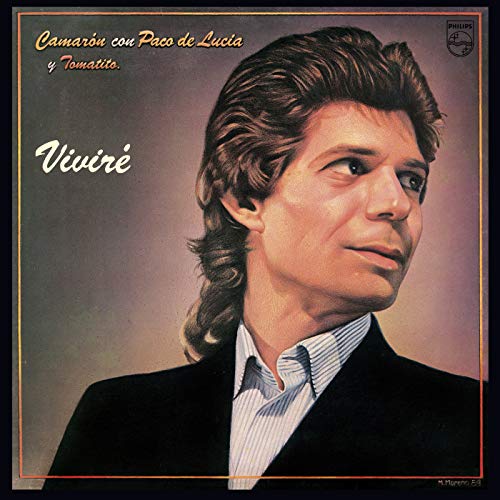
Viviré (Remastered 2018)








℗ 2018 Universal Music Spain, S.L.U. © 1984 Universal Music Spain, S.L.
Artist bios
With the death from lung cancer of Camarón de la Isla (born José Monge Cruz) on July 2, 1992, flamenco lost one of its greatest vocalists. The son of a basket-maker, de la Isla revolutionalized the flamenco tradition with his contemporary-minded approach. His debut 1969 album, Con la Colaboracion Especial de Paco de Lucia, recorded with the accompaniment of virtuosic guitarist Paco de Lucia, remains one of flamenco's classic recordings.
Although he retired from touring in 1979, de la Isla continued to produce groundbreaking albums. His 1980 album, La Leyenda del Tiempo -- which was marked by rock, jazz, and Oriental influences and the use of non-flamenco instruments, including bass, drums, percussion, electric piano, Moog, keyboards, electric guitar, flute, and zither -- sold nearly 6,000 copies. His 1989 recording, Soy Gitano, recorded with the Royal Philharmonic Orchestra, became the first album in Spain to be certified gold, with sales of 50,000 copies. De la Isla's last album, Potro de Rabia y Miel, followed two years later.
De Lucia paid tribute to his former collaborator with a tune, "Camaron," that he included on his 1998 album Luzia. The song marked De Lucia's debut as a vocalist. "While others sang songs with social content," De Lucia said, "Camarón's cracked voice could evoke, on its own, the desperation of a people."
The second of eight children, Camarón was born in the small Cadiz village of San Fernando. Acquiring his nickname, "Camarón," because of his blonde hair, he began performing in public at the age of eight.
In December 2000, Camarón's widow, Dolores "Chispa" Montoya, received the prestigious Golden Key Award of Song on his behalf. ~ Craig Harris
The role of the flamenco guitar evolved considerably through the playing of Paco de Lucia (born Francisco Sanchez Gomez). The son of flamenco guitarist Antonio Sanchez and the brother of a flamenco guitarist, Ramón de Algeciras, and flamenco singer, Pepe de Lucia, Paco de Lucia extended the former accompaniment-only tradition of flamenco guitar to include deeply personal melodic statements and modern instrumentation. His collaborations included ten albums with flamenco vocalist El Camaron de la Isla and work with American pianist Chick Corea and the Guitar Trio, featuring guitarists John McLaughlin, Larry Coryell, and Al DiMeola. His recordings with his sextet, which included his brothers Ramón and Pepe, include such groundbreaking masterpieces as La Fabulosa Guitarra de Paco de Lucia, Fantasia Flamenca, Fuente y Caudal, Almoraima, and Zyryab. Yet, de Lucia did not completely forsake traditional flamenco. His 1980 album, Interpreta a Manuel de Falla, paid homage to the classical composer and flamenco enthusiast, while his 1987 album, Siroco, marked a return to pure flamenco. "I have never lost the roots in my music," de Lucia said during a late-'90s interview, "because I would lose myself. What I have tried to do is have a hand holding onto tradition and the other scratching, digging in other places, trying to find new things I can bring into flamenco."
Born in Algeciras, a small city in southernmost Spain's Cadiz province, de Lucia was bred to be a world-class musician. He trained with his father and brother from the age of five. Mastering the art of flamenco guitar by his 11th birthday, he made his public performance debut on Radio Algeciras in 1958. A year later, he received a special award at the Festival Concurso International Flamenco de Jerez de la Frontera. Heralded as a child prodigy, de Lucia was invited to join the flamenco troupe led by dancer José Greco at the age of 16. He remained with the group for three years. A turning point in de Lucia's musical development came while on tour with Greco's troupe in North America. Meeting Sabicas, the first flamenco guitarist to tour the world, he was instructed to pursue his own style of playing. Although he remained tied to traditional flamenco on his first two solo albums -- La Fabulosa Guitarra de Paco de Lucia in 1967 and Fantasia Flamenca in 1969 -- and recorded ten albums accompanying flamenco vocalist de la Isla, de Lucia continued to seek a personal approach. The renowned guitarist died suddenly and unexpectedly of a heart attack in Mexico in February 2014; he was 66 years old. The city of Algeciras, de Lucia's birthplace, declared two days of official mourning. ~ Craig Harris
One of the best guitarists associated with the nuevo flamenco generation, Tomatito (born José Fernández Torres in AlmerÃa, Spain in 1958) grew up in a family of prestigious flamenco lineage, and at only 12 he had managed to impress none other than Paco de LucÃa. Still in his teens, Tomatito began to accompany famous cantaores, such as Enrique Morente and La Susi, but he attained definitive flamenco stardom as the great El Camarón de la Isla's guitarist of choice. Tomatito became Camarón's inseparable sidekick during the late singer's last 18 years of life, and took part in legendary tours and recordings such as La Leyenda del Tiempo. Tomatito also developed a solo career, dazzling audiences at festivals in Spain and abroad, playing at some of the world's most renowned venues, and winning countless accolades, as well as composing music for films and orchestra and collaborating on various projects by other artists. By 2013 he had released seven solo albums and one anthology. ~ Mariano Prunes
Language of performance
SpanishCustomer reviews
How are ratings calculated?
